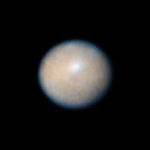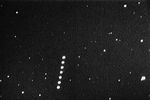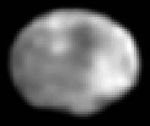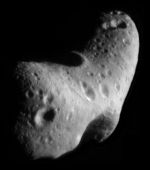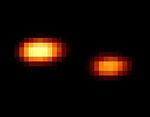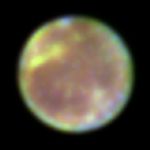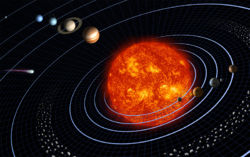Earth's solar system has several major asteroids, most of which can be found in the asteroid belt between Mars and Jupiter. A list of notable asteroids are below.
Contents
Ceres[edit]
Ceres was the first asteroid to be discovered and it is also the largest. It has been visited by the Dawn spacecraft, reaching it in March 2015.[1] It has been observed by the Hubble Space Telescope. Ceres is approximately 590 miles (950 kilometers) across and was first discovered in 1801 by Giuseppe Piazzi.[2] Ceres is named for the Roman goddess of agriculture, from which name the word cereal derives.
Pallas[edit]
Pallas is the third largest asteroid and named after the Greek goddess of wisdom, Pallas Athena.[3] It was found and named by astronomer Heinrich Wilhelm Matthäus Olbers on March 28, 1802. It has a diameter of 513 km.[3]
Vesta[edit]
Vesta was the fourth asteroid to be discovered and has a diameter of 525 kilometers (326 miles) and is smaller than the state of Arizona. It rotates about its axis in 5.34 hours.[4] It was visited by NASA's Dawn space mission in 2011-2012 before the Dawn probe headed off to Ceres.[1]
433 Eros[edit]
433 Eros is the second largest known Near Earth Asteroid with a diameter of 16.84 km.[5] It was discovered on August 13, 1898 by Schreiben von Herrn G. Witt.[6] As a Near Earth Asteroid, its orbit in mostly within that of Mars and pass within 14 million miles (22 million kilometers) of Earth.[6] It was also the first asteroid to be orbited and landed on by a spacecraft.[7] The Near Earth Asteroid Rendezvous Shoemaker mission was launched on February 17, 1996 and arrived at Eros on February 12, 2001.
617 Patroclus[edit]
617 Patroclus was discovered on October 17, 1906 by A. Kopff from Heidelberg, Germany. It is 87 miles (140 km) in size.[8] It is a Trojan asteroid.
Its companion object Menoetius was discovered on September 22, 2001 by William J. Merline, Laird M. Close, N. Siegler, D. Potter, C. R. Chapman, C. Dumas, F. Menard, and D. C. Slater using the Gemini North adaptive optics telescope at Mauna Kea, Hawaii.[9] It's nearly as large as 617 Patroclus almost 70 miles (112 kilometers) in size.[9]
Patroclus and Menoetius circle each other every 4.3 days at a distance of 680 kilometers.[9]
1036 Ganymede[edit]
The largest of the near-earth objects 1036 Ganymede has an estimated diameter of about 23.4 miles (37.7 kilometers).[10]
References[edit]
- ↑ 1.0 1.1 Mission Overview. Retrieved on 2018-10-05.
- ↑ Color View of Ceres. Retrieved on 2018-10-05.
- ↑ 3.0 3.1 Pallas. Retrieved on 2018-10-05.
- ↑ Vesta. Retrieved on 2018-10-05.
- ↑ 433 Eros (1898 DQ). Retrieved on 2018-10-05.
- ↑ 6.0 6.1 Eros. Retrieved on 2018-10-05.
- ↑ NEAR Shoemaker. Retrieved on 2018-10-05.
- ↑ 617 Patroclus (1906 VY). Retrieved on 2018-10-05.
- ↑ 9.0 9.1 9.2 (617) Patroclus and Menoetius. Retrieved on 2018-10-05.
- ↑ 1036 Ganymed (1924 TD). Retrieved on 2018-10-05.
Image Copyright info[edit]
| |||||||||||||||||||||||||||||
